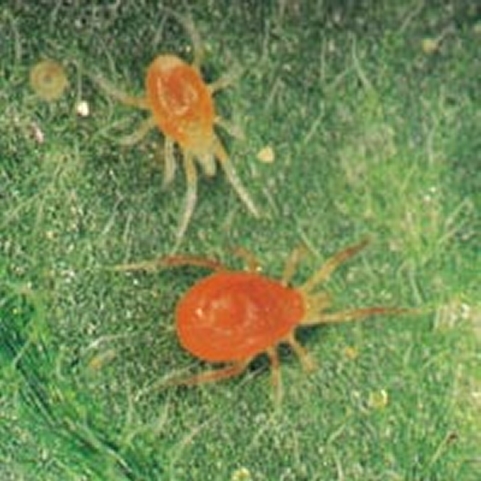Spider Mites

( Adult Spidermites at play )
Spidermites are not insects but arachnids, included in the same family as spiders. They have eight legs and are about the size of a poppy seed. Spider mites do damage to plants by inserting a tube-like structure into the plant's leaves and stems then suck out its juices. Indoors, where they are not combating nature's challenges, mites multiply quickly and overwhelm gardens. Mites cam lay eggs two weeks after hatching with females laying thousands of eggs over their lifetime. These eggs hatch quickly, within about three days of being laid.
Spraying miticides can be used to control mites through the vegetative stage and for the first two or three weeks of flowering. However, it can be harmful to spay pesticides on edible plants once they begin forming flowers and/or fruits.
There are several commercial miticides that can be used early in the season to kill mites. Pyrethrum is a natural pesticide produced by a close relative of the chrysanthemum and is commonly used to treat mite infestations. However, keep in mind that over-using pyrethrum may cause mites to become resistant to its insecticidal properties.
Ed Rosenthal's Zero Tolerance is a miticide derived from the oils of cinnamon, clove thyme and clove, which works to deter pests. It is very safe and can be used up to 5 days before harvest. Although it is primarily used as a foliar spray, it can also be used in the soil when diluted at a 3:1 ratio, water to Zero Tolerance.
Neem oil is a natural miticide derived from the nuts of the Neem tree, which is found in India. It is a mite repellent as well so some gardeners
use it as a prophylactic, spraying it on a weekly basis. Some people mix neem oil with Cinnamite to eliminate small infections. Cinnamite and neem oil are also used against powdery mildew.
For growers who distrust anything commercial, try an “herbal tea” that acts as a miticide. To each quart of water use a tablespoon each of ground cinnamon, ground clove and 2 tablespoons of ground Italian seasoning. Heat the mixture until it starts to simmer, then turn off the heat. Add 2 tablespoons crushed fresh garlic when the water cools to warm. Let the tea sit until it cools. Strain and save the water using a cloth or coffee filter. Add a few drops of liquid soap or dishwashing liquid to the water. It is ready to be sprayed on the leaf undersides. This mixture should help eliminate the mites naturally if it is sprayed every three days for two weeks after the initial wash.
Some gardeners have reported success controlling mites using other predatory insects such as ladybugs. These preditors reach an equilibrium with the herbivorous mites, keeping damage to a bare minimum. However, many gardeners report a low success rate using this method alone citing that a majority of the preditors simply fly away.
Ultimately, the solution pest problems in general is to prevent the garden from becoming infected. Following certain simple rules will help:
-Wear freshly washed clothes or change into a garden outfit when going into the garden. Pests can also be carried on shoes, so think like Mr. Rodgers and change shoes before entering the indoor garden area.
-Never work outdoors, especially in a garden or other vegetative or turf area right before working in your indoor garden.
-Don't use outdoor soil, tools or containers in the indoor garden. -If a plant is to be introduced to the garden, first do a close examination and then keep it in quarantine for five or six days. Re-examine it closely, especially the underside of leaves, before placing it in the garden with other plants.
-Close any unfiltered airways or holes through which plant pests might enter.
-Make sure that air intake from outside is filtered.
